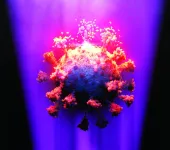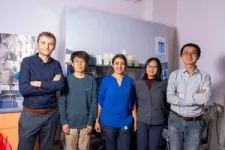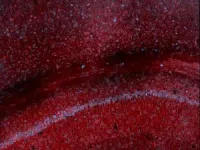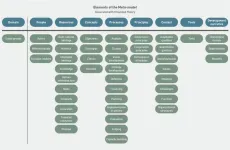(Press-News.org) New research has revealed how light can be used to destroy infectious coronavirus particles that contaminate surfaces. Scientists are interested in how environments, such as surgeries, can be thoroughly disinfected from viruses such as SARS-CoV-2 that caused the COVID-19 pandemic.
SARS-CoV-2 viral particles are composed of a core of nucleic acid chains that contain the genetic information of the virus, surrounded by a lipid membrane with proteinous spikes sticking out. Each component is necessary for infection.
Researchers from the University of Southampton investigated how ultraviolet laser light destroys the virus by impacting each of these critical components. By using a specialised ultraviolet laser at two different wavelengths the scientists were able to determine how each viral component degraded under the bright light. They found the genomic material was highly sensitive to degradation and protein spikes lost their ability to bind to human cells.
UV light includes UVA, UVB and UVC light. Very little UVC light at frequencies below 280nm reaches the earth’s surface from the sun. It is this lesser studied UVC light that the team in Southampton used for their study due to its disinfectant properties. UVC light is strongly absorbed by different viral components, including the genetic material (~260nm) and the proteinous spikes (~230nm), allowing the team to select laser frequencies of 266nm and 227nm for the project.
University of Southampton scientists, led by Professor Sumeet Mahajan, worked closely with scientists from the laser manufacturer, called M Squared Lasers, and the resulting co-authored study has been published in a journal of the American Chemical Society called ACS Photonics. The team found that 266nm light caused RNA damage at low powers, affecting the genetic information of the virus. 266nm light also damaged the structure of the SARS-CoV-2 spike protein, reducing its ability to bind to human cells by breaking down disulphide bonds and aromatic amino acids.
The 227nm light was less effective at inducing RNA damage, but more effective at damaging proteins through oxidation (a chemical reaction involving oxygen) which unfolds the protein’s structure.
Importantly, SARS-CoV-2 has among the largest of genomes for RNA viruses. This makes it especially sensitive to genomic damage.
Professor Mahajan said: “Light deactivation of airborne viruses offers a versatile tool for disinfection of our public spaces and sensitive equipment that may otherwise prove difficult to decontaminate with conventional methods. Now we understand the differential sensitivity of molecular components in viruses to light deactivation this opens up the possibility of a finely tuned disinfection technology.”
Light-based deactivation has received a lot of attention because of the wide range of applications where conventional liquid-based deactivation methods aren’t suitable. Now the mechanism of deactivation is better understood this is an important step in rolling out the technology.
Mechanisms of SARS-CoV‑2 Inactivation Using UVC Laser Radiation is published in ACS Photonics and is available online.
Contact
Steve Williams, Media Relations, University of Southampton press@soton.ac.uk or 023 8059 3212.
Notes to editors
Mechanisms of SARS-CoV‑2 Inactivation Using UVC Laser Radiation is published in ACS Photonics and is available at https://pubs.acs.org/doi/10.1021/acsphotonics.3c00828
For interviews with Professor Sumeet Mahajan please contact Steve Williams, Media Relations, University of Southampton press@soton.ac.uk or 023 8059 3212.
Image: Artist impression showing UVC light degrading SARS-CoV-2 viral particle. Credit University of Southampton
Additional information
The University of Southampton drives original thinking, turns knowledge into action and impact, and creates solutions to the world’s challenges. We are among the top 100 institutions globally (QS World University Rankings 2023). Our academics are leaders in their fields, forging links with high-profile international businesses and organisations, and inspiring a 22,000-strong community of exceptional students, from over 135 countries worldwide. Through our high-quality education, the University helps students on a journey of discovery to realise their potential and join our global network of over 200,000 alumni. www.southampton.ac.uk
www.southampton.ac.uk/news/contact-press-team.page
Follow us on X: https://twitter.com/UoSMedia
END
Scientists discover how ultraviolet light degrades coronavirus
2024-01-10
ELSE PRESS RELEASES FROM THIS DATE:
Tackling the effect of climate change on diarrheal diseases
2024-01-10
Diarrhoea is, globally, the second largest cause of death for children under 5. Contributing to more than 500,000 deaths, only pneumonia kills more children each year. Climate change, driving increased flooding and droughts, threatens the fragile progress made in reducing the burden of diarrheal disease over the past decades. Together with the Amsterdam Institute of Global Health and Development, Amsterdam UMC is set to lead a global consortium in the hunt for improved interventions.
"We see that the impact of climate change on diseases transmission depends on the constantly changing interaction between climate events, local ...
Do symptoms of post-traumatic stress disorder facilitate substance use as a coping method among children after a natural disaster?
2024-01-10
In a survey-based study of 3rd to 12th grade students in Puerto Rico after 2017’s Hurricane Maria, certain symptoms of post-traumatic stress disorder (PTSD) were linked with a higher risk of using drugs or alcohol.
The study, which is published in the Journal of Traumatic Stress, included 91,732 youths who completed a survey 5–9 months after Hurricane Maria made landfall in Puerto Rico. Associations between PTSD symptoms and substance use were examined using a network conceptualization, which views disorders as stemming from interactions ...
Microplastics affect soil fungi depending on drought conditions
2024-01-10
Moisture levels in the soil can impact the effects that microplastic pollution has on soil fungi, according to new research published in Environmental Microbiology.
By studying soil samples mixed with microplastics under different conditions, investigators found that when soil is well-watered, toxic chemicals in microplastics can leach into the soil and hinder soil fungal richness. With dry soil, however, the leaching of water-extractable chemicals is less pronounced and therefore less impactful on soil fungal structure.
The researchers also noted that under dry conditions, microplastics help soil hold water for longer, which could help ...
Is a commonly used screening tool for cognitive impairment accurate in diverse populations?
2024-01-10
A screening tool often used in primary care clinics to detect cognitive impairment has shortcomings when applied to ethnically and linguistically diverse older adults, according to a study published in the Journal of the American Geriatrics Society.
The study looked to see whether currently published English and Spanish cut points for cognitive impairment in the Montreal Cognitive Assessment (MoCA) are appropriate in diverse community-based adults aged 65 years or older with cognitive concerns in the Bronx, New York. There were 231 participants (43% ...
Do individual-level mental health interventions improve employees’ wellbeing?
2024-01-10
Many businesses are making efforts to promote workers’ wellbeing, and numerous interventions are available at the individual and organizational levels. New research published in the Industrial Relations Journal found no evidence that individual-level mental wellbeing interventions like mindfulness, resilience and stress management, relaxation classes, and wellbeing apps benefit employees.
The study was based on survey data from 46,336 workers in 233 organizations in the UK. Across multiple subjective wellbeing indicators, participants in individual-level mental wellbeing interventions appeared no better off than other workers.
The study’s ...
Discovery of immense fortifications dating back 4,000 years in north-western Arabia
2024-01-10
The North Arabian Desert oases were inhabited by sedentary populations in the 4th and 3rd millennia BCE. A fortification enclosing the Khaybar Oasis—one of the longest known going back to this period—was just revealed by a team of scientists from the CNRS1 and the Royal Commission for AlUla (RCU). This new walled oasis is, along with that of Tayma, one of the two largest in Saudi Arabia. While a number of walled oases dating back to the Bronze Age had already been documented, this major discovery sheds new light on human occupation in north-western Arabia, and provides ...
Higher viral load during HIV infection can shape viral evolution
2024-01-10
A new paper in Molecular Biology and Evolution, published by Oxford University Press, finds that HIV populations in people with higher viral loads also have higher rates of viral recombination. In effect, the more HIV in the blood, the easier it is for the virus to diversify.
One of the reasons HIV has historically been so difficult to combat is the virus’s exceptionally high rate of recombination. Recombination enables the exchange of genetic information across strains of the virus and drives HIV’s evolution within people. This genetic exchange ...
More than 900 chemicals, many found in consumer products and the environment, display breast-cancer causing traits
2024-01-10
With tens of thousands of synthetic chemicals on the market, and new ones in development all the time, knowing which ones might be harmful is a challenge both for the federal agencies that regulate them and the companies that use them in products. Now scientists have found a quick way to predict if a chemical is likely to cause breast cancer based on whether the chemical harbors specific traits.
“This new study provides a roadmap for regulators and manufacturers to quickly flag chemicals ...
Agility in cultural heritage management—Advancing competence within uncertainty as a sustainable and resilient adaptation to processes of dynamic change
2024-01-10
The intense changes in our modern society and the associated challenges are constantly increasing, not least due to the meta-crisis of climate change. Yet our approach to cultural heritage is still strongly influenced by the narrative of preservation. The article aims to find solutions within the interplay of preservation and change. Based on the psychological impact on society resulting from the current challenges, it is argued that cultural heritage experts need competencies in dealing with uncertainty and tolerance of ambiguity in order to provide security of action. The article applies insights from multiple disciplines to urban environment studies and advocates for a systemic understanding ...
Prestigious American Historical Review showcases UT class where video games meet history
2024-01-10
Tore Olsson put his students in touch with American history through his popular and award-winning class “Red Dead America: Exploring America’s Violent Past Through the Hit Video Games.” Now this engagement has reached beyond the classroom—the historical profession’s most prestigious journal, the American Historical Review, just published a major feature on the class as an example of creative and innovative history teaching.
Olsson is an associate professor and director of graduate studies in UT’s Department of History. His focus as a historian is the United States since the Civil War, with a particular interest in the US South, ...





